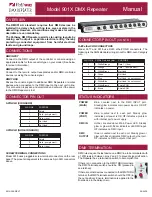
BASIC OPERATION
When applying power for the first time after the purchase
of the repeater, be sure to confirm the following points:
3 ) R o t a t e t h e [ S Q U E L C H ] c o n t r o l m a x i m u m
counterclockwise and confirm that the [BUSY] in-
dicator lights up in green.
1)
That the [COR SIMULATE] switch is OFF.
2)
That the [VOLUME] control is rotated maximum
counterclockwise.
4) Rotate the [VOLUME] control clockwise and adjust
it as desired as the noise comes from the speaker.
3-2 OPERATION
For open repeaters:
1) Turn the [POWER] switch ON. The [POWER] in-
dicator lights up in green.
l
If the [POWER] indicator lights up in red, AC power
is not applied to the repeater. Make sure the AC
cable is correctly connected.
l
When using only DC power, turn the [POWER]
switch ON then push the [DC RESET] switch to
apply power. Confirm that the [POWER] indicator
lights up in red.
2) Set repeater mode for either a private or
repeater.
For private repeaters:
Push the [CTCSS] switch ON. The [CTCSS] in-
dicator lights up and the repeater transmits only
received signals with specified subaudible tones su-
perimposed on them.
Push the [CTCSS] switch
to
turn OFF the tone
squelch function if the [CTCSS] indicator lights up.
The repeater transmits all receive signals if the
[CTCSS] indicator does not light up.
3) That the [SQUELCH] control is rotated maximum
clockwise.
4) That the supplied HM-4 microphone is connected to
the mic connector.
5) Rotate the [SQUELCH] control clockwise until the
[BUSY] indicator goes OFF and noise from the
speaker disappears.
l
The level of this control determines the level of the
input signals to be repeated. Adjust [SQUELCH]
as required to repeat only strong signals.
6 ) R o t a t e t h e [ V O L U M E ] c o n t r o l m a x i m u m
counterclockwise as the monitor signal from the
speaker is not related to repeater functioning
l
MICROPHONE FUNCTION
Push and hold the
switch on the microphone
to transmit your voice.
The repeater functions as a transceiver when [LOCAL
INHIBIT] is ON and the PTT switch is pushed. Speak
into the microphone using your normal voice level.
Be sure not to overlap voice signals on the
tion of received signals. See p. 5 for additional
l
COR SIMULATE FUNCTION
The repeater can be set in continuous transmit mode
for checking repeater operation when
SIMU-
LATE] is pushed IN. Check the following functions.
1. Time-out timer
2. Hang-up timer
3. Repeat stopping time
4.
ID speed
5. ID function
Summary of Contents for C RP1520
Page 1: ...c...
Page 4: ......
Page 8: ......
Page 13: ......
Page 15: ......
Page 16: ......
Page 17: ......
Page 20: ...m m 7 INSIDE VIEWS...
Page 21: ...INSIDE VIEWS 7 7 2 BOTTOM VIEW...









































